| dc.description.abstract | Learner underperformance, especially in poor school communities has been an issue of contestation since 1994, and remains a major challenge in South Africa. Learner performance in this category of schools continues to plummet amidst government efforts to reallocate resources, and adjust policies to meet the needs of these schools, as well as efforts made by researchers to identify the causes of underperformance. The variances in performance exhibited by schools within this category, often within the same community, and with shared features indicate the need for further exploration of the phenomenon. This study examined three Quintile-1 (Q-1) schools within a particular informal settlement in Cape Town using the Capability Approach (CA) pioneered by the economist and philosopher, Amartya Sen as a conceptual framework to understand the nature of learner performance. An investigation was undertaken in the three Q-1 schools using a qualitative research paradigm. The investigation was underpinned by the constructs of the CA which include; Freedoms, Unfreedoms, Capabilities, Conversion, and Functionings. These components were used in the investigation to understand the nature of learner performance in the schools, and how each of these constructs influenced the gap between available resources and learner performance. This approach was guided by the assumption that these schools accumulate a similar amount of resources, face similar challenges and have learners from similar backgrounds. The investigation revealed that capability limitations and unfreedoms interplay to limit learner abilities to learn and perform. As such, a framework is proposed for understanding learner performance in a Q-1 school community via the capability sets of Amartya Sen. The findings of the study reveal that learner capabilities, as well as their abilities to perform, were limited by existing unfreedoms present in the school community where role players are challenged to convert resources into valued functionings. Notable was the fact that learner backgrounds and circumstances contributed to unfreedoms experienced in the classrooms. The findings also reveal that efforts made through the reallocation of resources are under pressure, because of the plethora of factors at play in the community, the school and the Department of Basic Education. The study emphasizes the usefulness of the CA in educational spaces, considering its importance in the understanding of significant variables that are often neglected in performance discourses, with a focus on the explication of capability sets. | en_US |

